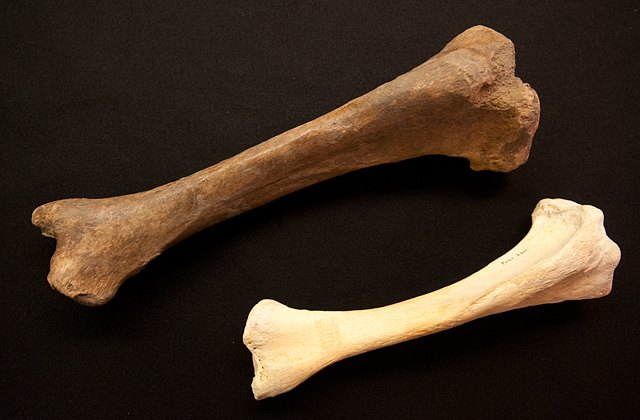Fossils from an Ice Age giant short-faced bear are now on display at the University of Iowa Museum of Natural History.
A southwest Iowa farmer discovered the bones of the bear on his farm in 2008 and loaned them to the UI. After a time-consuming process of analysis and verification, UI scientists have now confirmed that the find is the first verified short-faced bear specimen found in the state, say Holmes Semken, UI professor emeritus of geoscience, and Trina Roberts, associate director of the UI Museum of Natural History.
Joe Walker of Brayton made the discovery in the back dirt of a USDA flood control dam along Troublesome Creek, near Atlantic.
“The bone was unusually large and my first thought was that it could be from something extinct,” Walker says. He had the bone identified by U.S. Department of Agriculture archaeologist Richard Rogers of Des Moines, who identified the bones, a tibia and pelvis fragment, as belonging to Arctodus simus, commonly known as the giant short-faced bear.

The giant short-faced bear is the largest mammalian land carnivore ever to live in North America, reaching heights of over 11 feet when standing upright. They lived from 1.6 million to 11,000 years ago alongside giant ground sloths, mammoths and, near the end of the Ice Age, the first Native Americans to enter Iowa.
“My first reaction was what the heck is a short-faced bear?” says Walker. “I had never heard of it and had a hard time imagining that such a huge bear existed in this area. What I find most impressive about this bear species is its size, ferocity, and the fact that it co-existed with humans for a time.”
“It's not a surprise that one was found here,” Roberts explains, “because the distribution of previous finds is quite broad across North America and surrounds Iowa. But it is a confirmation that they were here. That also means that this specimen may be important in understanding the biology of short-faced bears, because it can help us determine what traits are consistent across the species' wide range.“
Future research will likely involve chemical and physical analyses to determine diet and behavior as well as the age of the fossils, says Semken, a paleontologist who studies Pleistocene mammals.
“These tests give us information about this individual bear and about the species as a whole,” Semken added. “Because specimens are rare each additional one adds unique information, especially one like this that comes from a new geographic area. For example, most of what's known about the diet of Arctodus comes from chemical analysis of Alaska specimens, and it should be quite interesting to compare that to Iowa.”
UI researchers have already collaborated with colleagues at UI Hospitals and Clinics and the College of Engineering to CT-scan the specimens, allowing prototype replicas to be made that will be used for educational programming.
The short-faced bear bones are displayed in a special temporary exhibit. The museum is open 10 a.m. to 5 p.m. Tuesday through Saturday, 10 a.m. to 8 p.m. Thursday and 1-5 p.m. Sunday. For more information about the Museum of Natural History see the website.